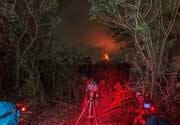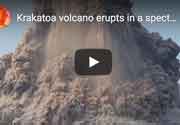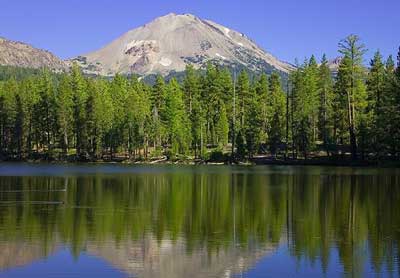Etna volcano eruption updates: November 2013
Update Sat 30 Nov 08:46
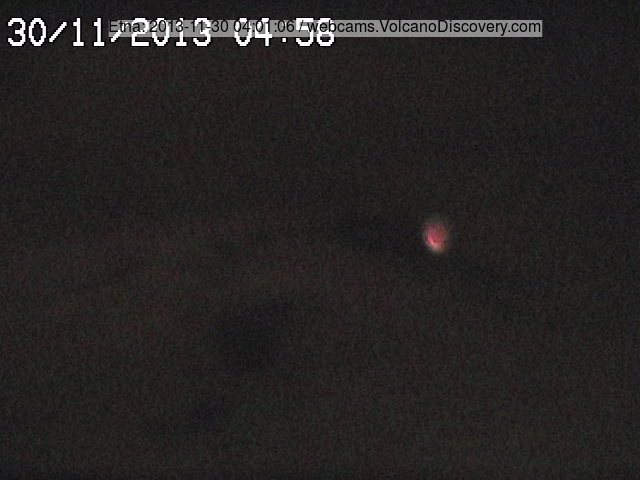
Weak glow from the New SE crater's summit vent this morning

Current tremor signal (ESLN station, INGV Catania)
The New SE crater has calmed down. Only very occasionally, a weak glow appeared from the summit vent at night, suggesting deep-seated activity still occurs from time to time.
Update Fri 29 Nov 07:23
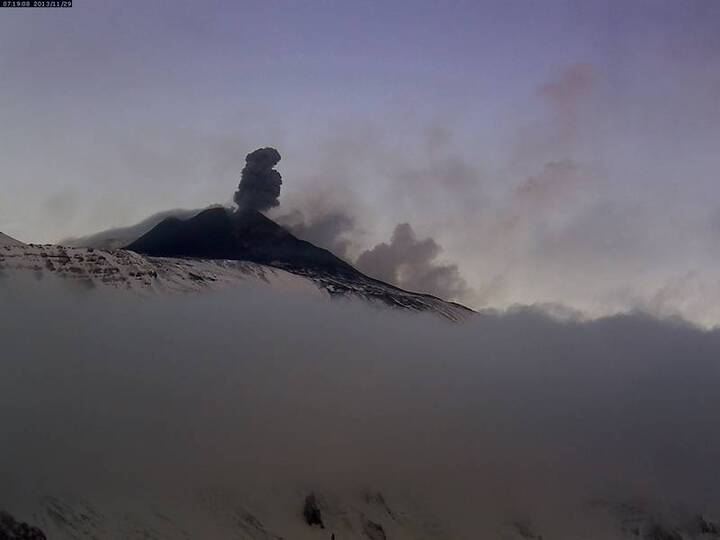
Strombolian explosion from Etna's New SE crater

Current tremor signal (ESLN station, INGV Catania)
Although the paroxysmal phase of the eruption ended at night, tremor has remained elevated and strombolian explosions continue to occur from the summit vent of the NSEC.
Etna's 18th paroxysm - the complete video
Update Fri 29 Nov 00:42
Update Thu 28 Nov 23:52
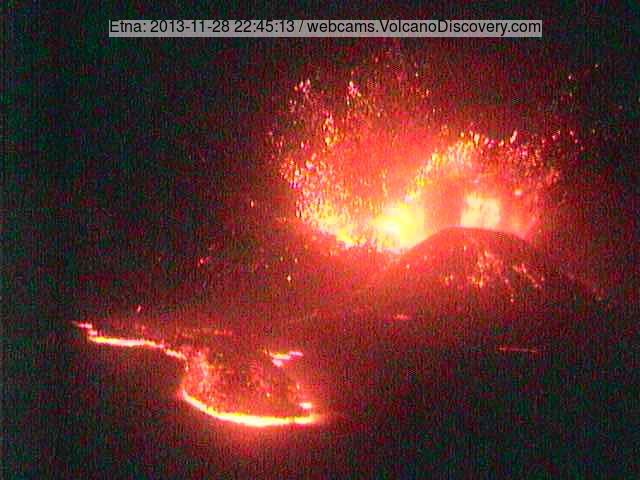
Advancing lava flow to the south and giant lava bubble explosion

Current tremor signal (ECPN station, INGV Catania)
Tremor continues to decrease slowly after it had reached an impressive peak. The New SE crater continues to produce intermittent fountains and impressive lava bubble explosions and the lava flows continue to advance to the south and SE.
Update Thu 28 Nov 23:08
At the peak of the paroxysm, a lava flow starts to flow out from the saddle vent and forms a delta south of the SE crater complex advancing towards the camera's viewpoint, with two branches (to the S-SW and SE), similar as during the past paroxysms.
Update Thu 28 Nov 22:53
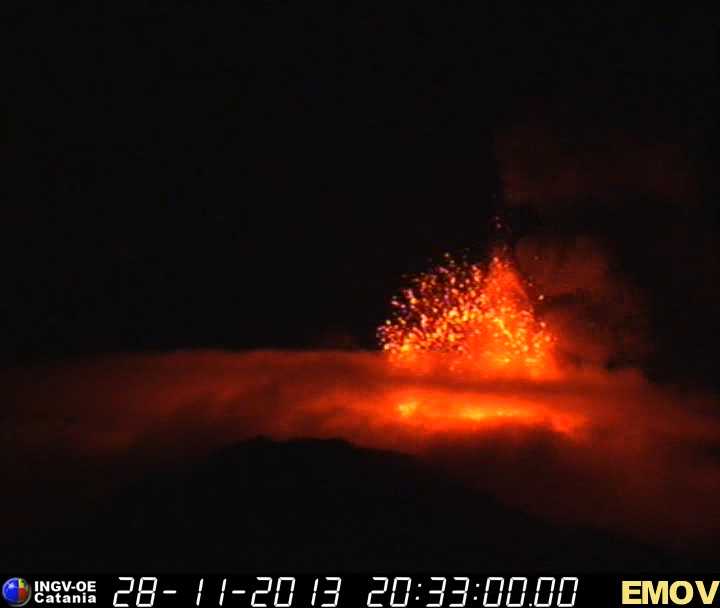
Exploding lava bubble (Montagnola webcam, INGV Catania)

Current tremor signal (ESLN station, INGV Catania)
The eruption seems to have past its peak now. Tremor has decreased a bit and fountaining seems less intense. Occasionally, the volcano produces giant spectacular lava bubbles that explode over the New SE crater.
A lava flow is being emitted from the saddle vent. At least one branch is turning SE in direction towards the Valle del Bove rim as the following video shows:
Update Thu 28 Nov 21:04

INGV webcam image from Montagnola webcam showing 2 fountains

Current tremor signal (ESLN station, INGV Catania)
The eruption continues to increase and there are now at least 2 vents producing lava fountains.
Video from the eruption so far
Update Thu 28 Nov 20:33
Update Thu 28 Nov 20:26
The eruption is still increasing; intermittent views from the webcam show strong lava fountains.
Catania airport closed because of Etna's ash plume
Update Thu 28 Nov 19:25
The ongoing (and still increasing) eruption of the New SE crater has forced the closure of the airspace around and the airport of Catania itself.
Update Thu 28 Nov 18:04
The eruption is still increasing and probably approaching its peak intensity now.
18th New SE crater paroxysm
Update Thu 28 Nov 17:44
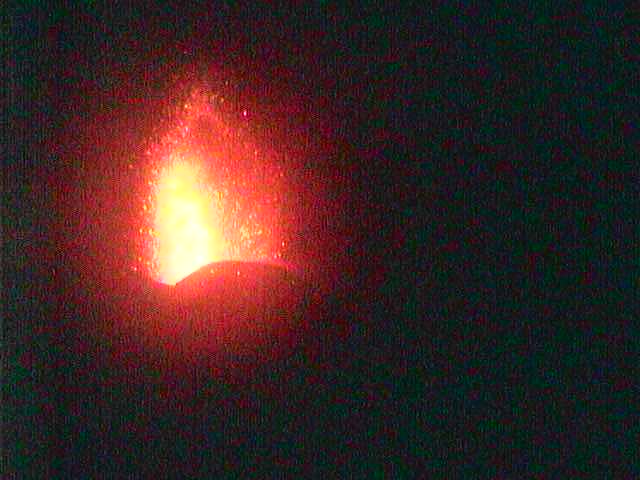
Lava fountain from the New SE crater

Current tremor signal (ESLN station, INGV Catania)
The 18th paroxysm is in full swing. From the webcam SW from Monte Frumento Supino, lava fountains can be seen rising from the New SE crater.
Update Thu 28 Nov 16:15

Current tremor signal (ESLN station, INGV Catania)
The tremor amplitude has started to rise quickly, which could be the beginning of a new paroxysm. Thick cloud cover prevent direct observations to check whether there is strombolian activity at the New SE crater at the moment.
Update Thu 28 Nov 07:09

Glow from Etna's New SE crater at night

Current tremor signal (ESLN station, INGV Catania)
In the second half of the night, the glow from the summit vent of the New SE crater became more intense and frequent. Tremor has remained low.
Update Wed 27 Nov 11:49
No significant changes have occurred. The New SE crater remains restless with some occasional weak activity, visible from time to time as faint glow on the webcam at night. Tremor is currently low.
Update Tue 26 Nov 10:19
No changes in activity have occurred since yesterday. Very occasionally, glow from the summit vent at the NSEC and from a vent at its southern base is visible, suggesting ongoing sporadic deep-seated explosions inside the cone. Tremor is low at the moment.
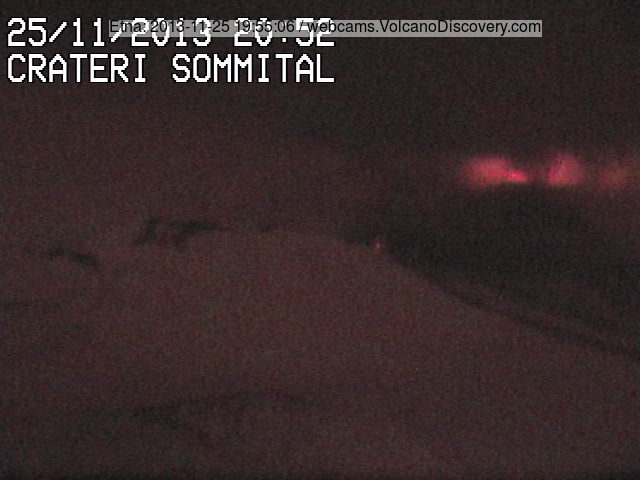
Glow from Etna's New SE crater last evening
Update Mon 25 Nov 11:32
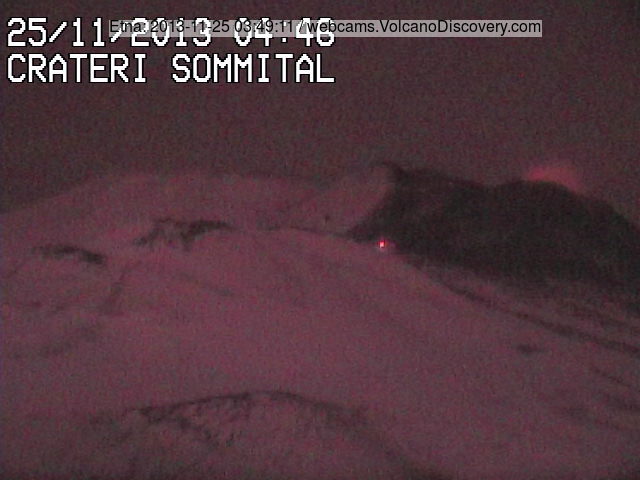
Glow from Etna's New SE crater this morning
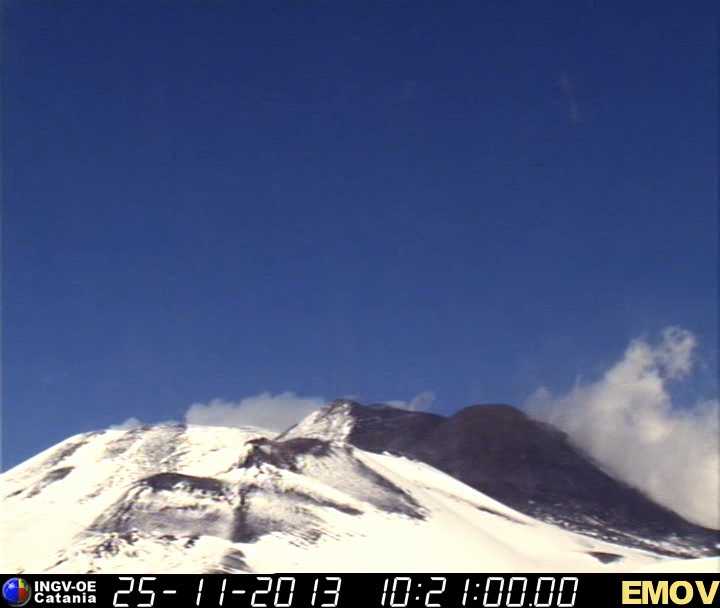
The NSEC producing steam rings today
The New SE crater is restless. Occasional glow from the summit vent suggest that deep-seated strombolian activity continues. At the same time when this activity was visible, a glowing spot at the southern base was present as well. This could be a small effusive vent that is activated briefly during phases the magma column rises high enough inside the conduit.
Also today, the volcano produces nice steam rings. Tremor is currently low.
End of paroxysm
Update Sat 23 Nov 12:30

View of Etna from Catania

Current tremor amplitude (ECPNZ station, INGV Catania)
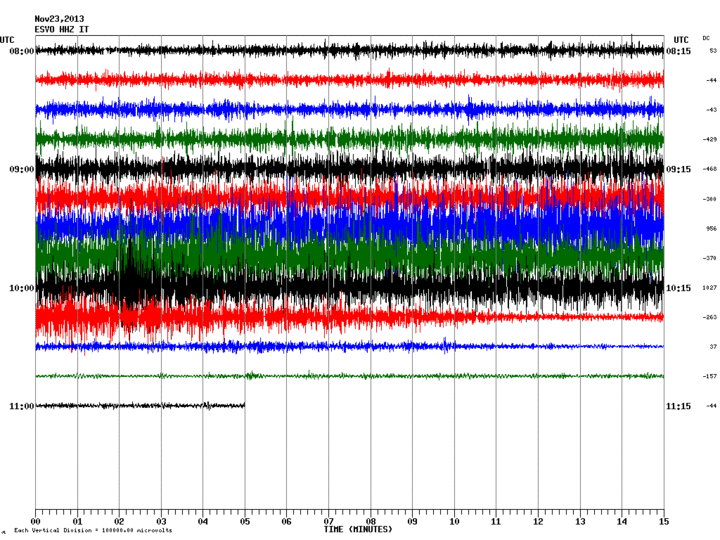
Current seismic signal (ESVO station, INGV Catania)
The 17th paroxysm has already ended. It was much faster and weaker than the previous ones and the intense phase of lava fountains and emission of a tall ash plume lasted only about one hour.
Time-lapse video of the eruption this morning.
Etna continues to produce beautiful steam rings.
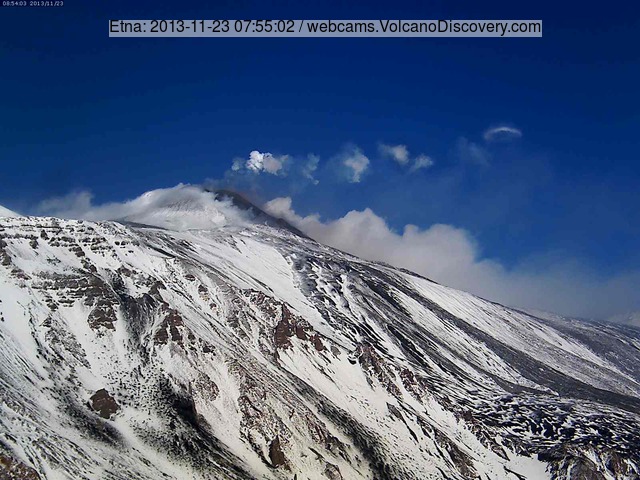
Steam ring from New SE crater this morning
New SE crater paroxysm Nr 17
Update Sat 23 Nov 10:37

Eruption at the New SE crater (Etna Trekking webcam from Schiena dell'Asino)

Current tremor signal (ESLN station, INGV Catania)
The latest paroxysm (number 17 in 2013) at the New SE crater started this morning. Strombolian explosions increased quickly and are now merging into lava fountains. The tremor is steeply rising. You can follow the activity live at
webcams.volcanodiscovery.com (or if you are on a small mobile display, at
the mobile optimized version).
Weak explosive and effusive activity at New SE crater
Update Fri 22 Nov 18:24
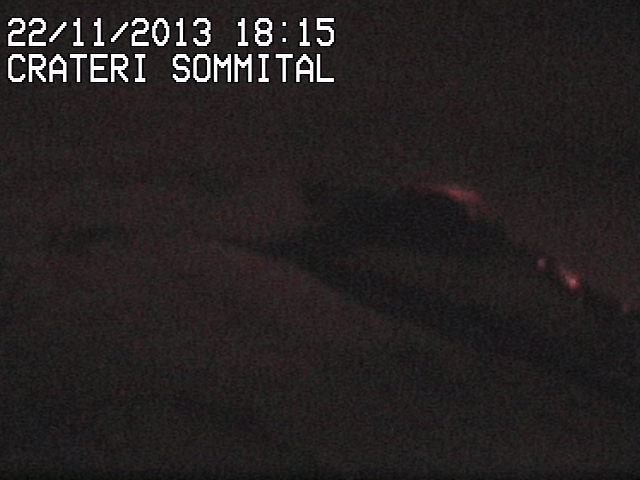
New SE crater of Etna this evening
The New SE crater is not completely quiet: there are small strombolian explosions, sometimes with lava ejections and sometimes only indicated by occasional weak glow from both the summit vent. In addition, at the same time increased glow is visible at the effusive vent on the east side of the cone. The latter has shown a similar behavior for the past two weeks before and after the main phases of the eruption. It seems to become active whenever the internal pressure in the conduit increases during explosions, and reacts by squeezing out small amounts of lava.
Update Fri 22 Nov 12:13

Current tremor signal (ESLN station, INGV Catania)
The New SE crater has remained calm, although tremor is still slightly elevated and shows a weak rising tendency. Will the volcano maintain its "habit" to produce another show over the weekend?
Update Tue 19 Nov 18:16
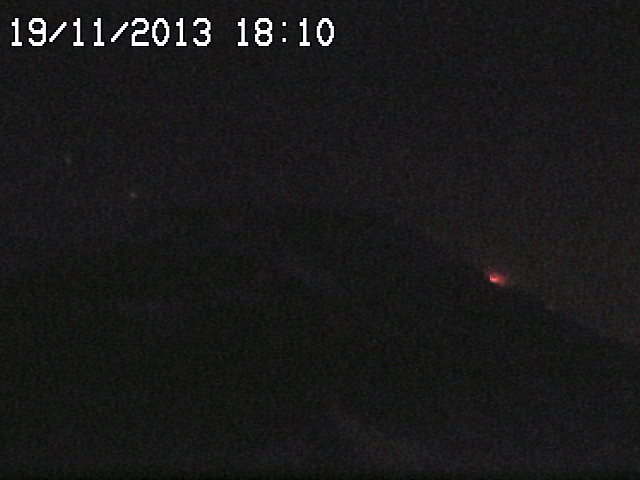
Weak glow from the eastern effusive vent at Etna's New SE crater

Current tremor signal (ESLN station, INGV Catania)
Weak explosive (sporadic small strombolian eruptions) and effusive activity (weakly alimented lava flow from eastern fissure vent) continues at a decreasing trend. There are interesting small surges of activity at rhythmic intervals of 3-4 hours (visible as the smaller peaks in the tremor signal).
Update Mon 18 Nov 18:50

Weak activity last evening from the New SE crater

Current tremor signal (ESLN station, INGV Catania)
Activity has gradually decreased since the last paroxysm, with short peaks of renewed stronger activity in between. As of now, weak explosions probably still continue at the New SE crater but cannot be observed due to cloud cover. Tremor signal is still elevated but with a an overall decreasing tendency.
Intense strombolian at New SE crater
Update Sun 17 Nov 17:53
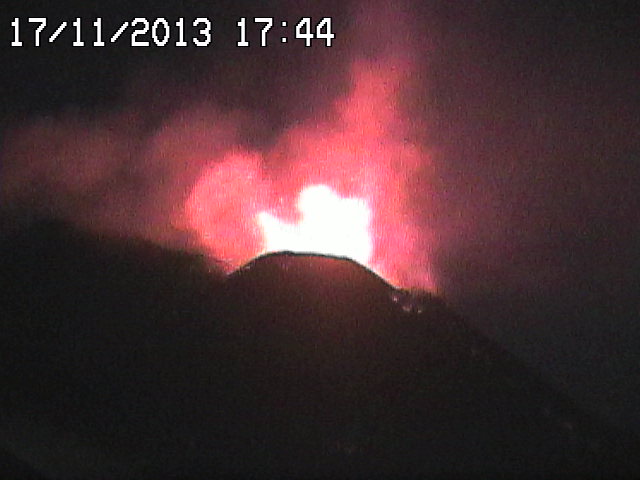
Explosion at NSEC this evening

Current tremor amplitude (ESLN station, INGV Catania)
Eruptions continue. Bright lava explosions occur at the New SE cone and tremor levels remain high.
Update Sun 17 Nov 11:57
The tremor signal has started to rise again and the explosions that continued at the New SE crater have become bigger as well. Is a "follow-up" paroxysm in the making?

Current tremor signal (ESLN station, INGV Catania)
16th New SE crater paroxysm
Update Sun 17 Nov 10:10
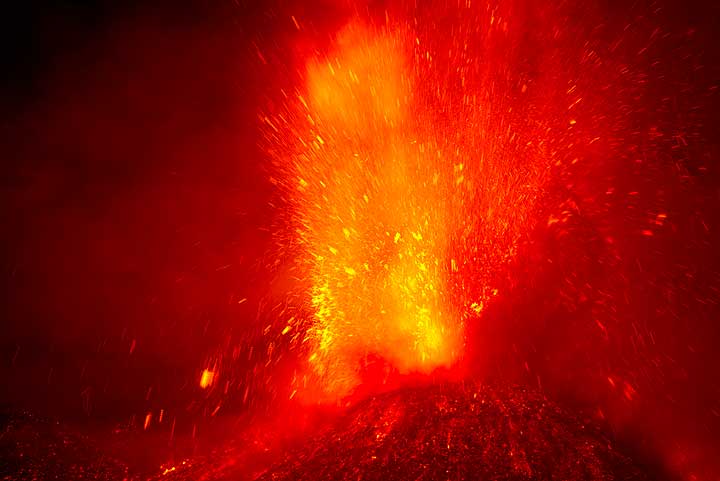
Lava fountains during the paroxysm last night

Current tremor signal (ESLN station, INGV Catania)
As expected, the 16th (in 2013) paroxysmal eruption took place at the New SE crater over night.
The main phase lasted about 5 hours between midnight and shortly before dawn. It consisted of violent pulsating lava fountains reaching 300-600 m height, thundering explosions of giant magma bubbles that ejected large glowing, liquid spatter to hundreds of meters distance in radial directions, and the effusion of several lava flows.
The first lava flow was erupted from the fissure vent between the old and new SE crater and traveled to the south as far as the former Torre del Filosofo area, on top of the much larger flow from last week (11 Nov). A second flow was active from the eastern fissure of the cone, traveled east and bent NE at the 2008 vents and a few 100 m or so into Valle del Bove. The third flow was erupted to the NE towards the Valle del Leone, similar as during the previous paroxysm. In comparison, lava flow output was much less than during the past eruptive phase 6 days ago.
The New SE crater continued to produce frequent strombolian explosions in the morning afterwards, again, in much the same way as at the end of the previous paroxysm.
Update Sat 16 Nov 17:46

Strombolian explosion at the NSEC

Current tremor signal (ESLN station, INGV Catania)
Intense strombolian activity is occurring at the New SE crater. Tremor has been climbing slowly, and it seems more and more likely that the next paroxysm is about to start in a near future.
Rising tremor
Update Sat 16 Nov 09:52
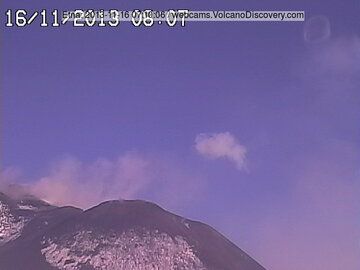
Steam rings from Etna's New SE crater this morning
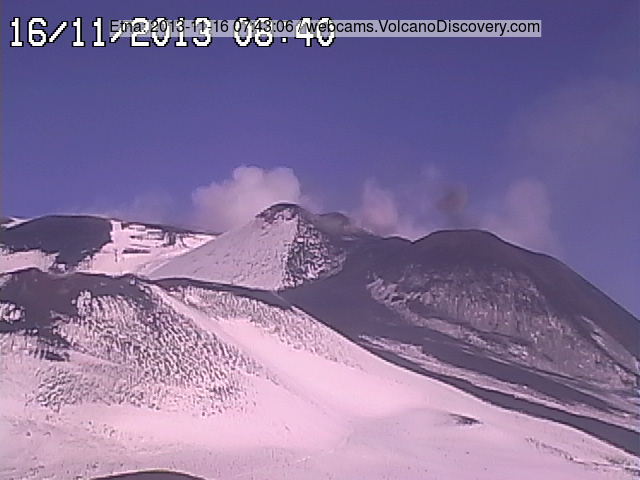
Weak ash explosion from NSEC

Current tremor signal (ESLN station, INGV Catania)
Weak explosions continue at the New SE crater, and often produce steam rings. This morning, tremor has started to rise, which could indicate the start of yet another paroxysm.
Update Fri 15 Nov 17:56
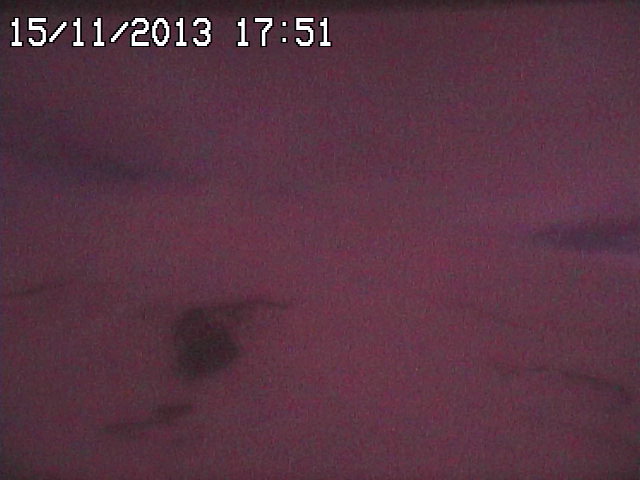
Glow from Etna's New SE crater

Current tremor signal (ESLN station, INGV Catania)
Explosions continue at the New SE crater. The weather is mostly bad and visibility is limited, but the glow seen on the webcams speaks for itself. Tremor continues to climb slowly. Are we in for another paroxysm soon?
Update Thu 14 Nov 13:39

Current tremor signal (ESLN station, INGV Catania)
Activity at the New SE crater has decreased during the night, but probably weak strombolian explosions still occur from time to time. At the moment, weather is very bad and visible observations difficult. The tremor decreased as well, but has gained again and continues to show an overall increasing trend, similar to the days before the 10-11 Nov paroxysm.
Increasing activity
Update Wed 13 Nov 18:39
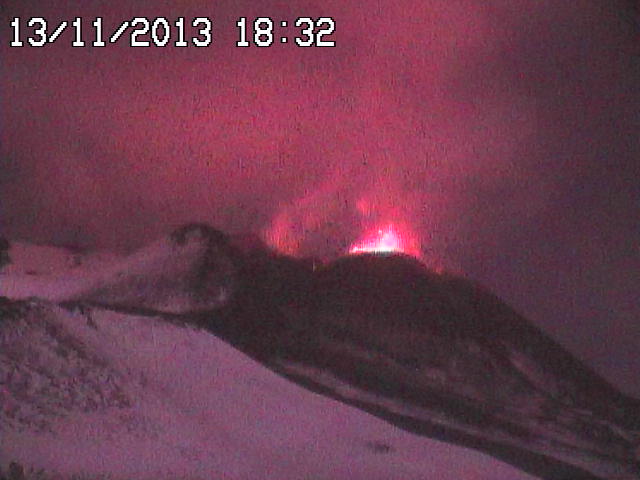
Strombolian activity at the New SE crater

Current tremor signal (ESLN station, INGV Catania)
Strombolian activity at the New SE crater has picked up in the evening and tremor is rising. I seems that there are two active vents, the summit one with bright explosions and one with glow and steaming at the saddle (or from a lava flow on the north flank).
It would not be the first time, Etna has two paroxysms in a short time interval...
Weak strombolian explosions
Update Wed 13 Nov 12:24
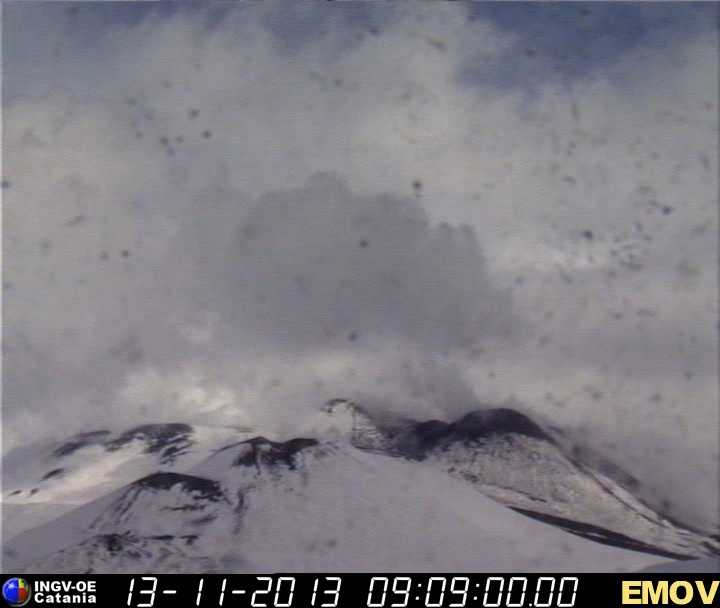
Weak explosion from Etna's New SE crater today

Current tremor signal (ESLN station, INGV Catania)
Weak explosive activity has resumed yesterday evening (or, more likely, continued from 11 Nov) at the New SE crater. Weather conditions are currently very bad, but the webcams occasionally show this activity. Tremor has picked up a bit, suggesting that another paroxysm could occur in a near future.
The latest paroxysm has greatly enlarged the field of young lava flows south of the SE cone, including the upper sections of the access road. Unfortunately, the Torre del Filosofo seismic station (ETFI) of INGV was buried under lava from the 10-11 Nov paroxysm and several other monitoring stations might face a similar fate if similar eruptions continue to occur.
The last recorded signal from the Torre del Filosofo seismic station (ETFI), showing the tremor intensity at unprecedented levels. If the eruption size is more or less proportional to the integral of the tremor amplitude, this illustrates the size of the paroxysm:

Tremor amplitude (EFTI station), cut off in the morning of 11 Nov when the station was covered by lava
Update Tue 12 Nov 15:32

Current tremor signal (ESLN station, INGV Catania)
Strombolian activity at the NSEC ceased during the night, and the lava flows from the last paroxysm are no longer active today. Tremor has returned to low levels.
Continuing strong strombolian activity
Update Mon 11 Nov 21:12
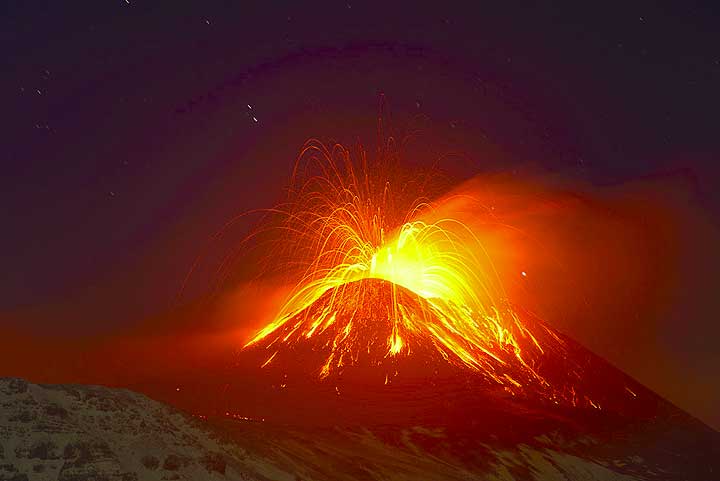
Large explosion lava bubble at Etna's New SE crater this evening

Current tremor signal (ESLN station, INGV Catania)
Intense strombolian activity continues at the New SE crater. When observed this afternoon and evening, mild to strong explosions have occurred at intervals of few seconds to minutes. Sometimes, they could be described as spattering, while at other times, large and noisy detonations caused by large bursting bubbles sent glowing lava bombs into circular paths several hundreds meters height and distance. An effusive vent remains weakly active at the upper eastern flank of the cone.
Tremor levels had rapidly decreased at the end of the fountaining of the paroxysm, but not completely dropped. (often at intervals
New SE crater paroxysm (#15)
Update Mon 11 Nov 10:17

Current tremor amplitude (ECPNZ station, INGV Catania)

Etna from Schiena dell'Asino
The awaited new paroxysm of Etna's NEW SE crater started last night and is still in full progress. Unfortunately, a snow storm above the summit area prevents detailed observations, but judging from the seismic signal, this eruption is unusually long and intense (and still growing at the time of updating). Ash fall has been reported from villages to the E/NE (Zafferana, Milo etc), where the plume is carried to by strong Libeccio winds.
Update Sun 10 Nov 20:00
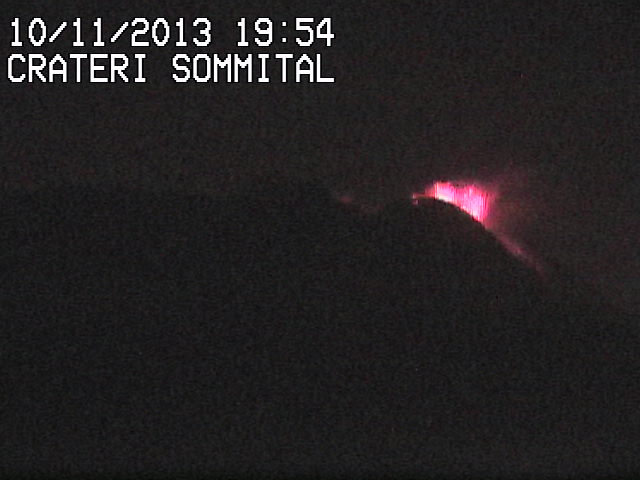
Explosions from the NSEC

Current tremor amplitude (ECPNZ station, INGV Catania)
The newest paroxysm at the NSEC seems to have started. Tremor rises sharply and explosions are becoming nearly continuous.
Continuing strombolian explosions at NSEC
Update Sun 10 Nov 11:18

Current tremor amplitude (ECPNZ station, INGV Catania)
Strombolian explosions (sometimes relatively large) from the New SE crater continued with little changes. Tremor levels show a no indication whether or not a new paroxysm is going to occur soon. A very slow rising trend is visible over the past week.
Update Sat 09 Nov 15:18
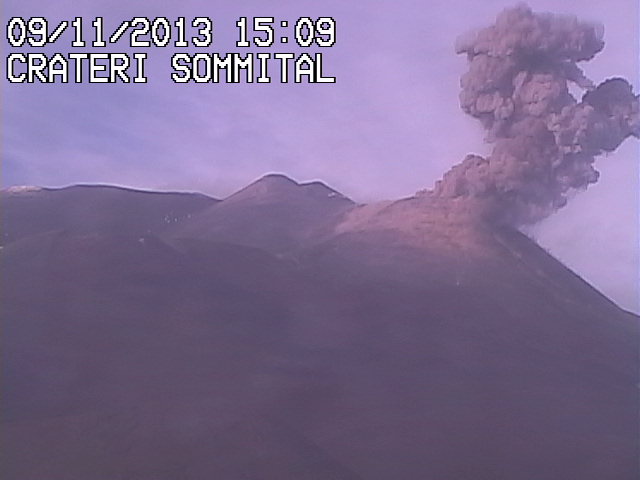
Explsion from Etna's New SE crater this afternoon

Current tremor amplitude (ECPNZ station, INGV Catania)
A relatively large explosion has occurred some minutes ago. Volcanic tremor still doesn't show a clear trend.
Update Sat 09 Nov 09:21
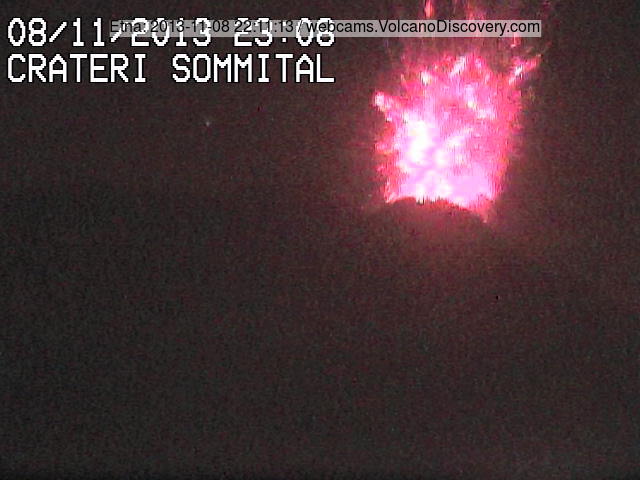
Explosion last night at 23:08 from Etna's New SE crater

Current tremor amplitude (ECPNZ station, INGV Catania)
Very infrequent explosions (at least one) occurred during the night, and tremor has again picked up a slowly rising trend, but is far from conclusive at the moment whether and when a next paroxysm might occur. Strangely, many of the previous ones have occurred on Saturdays (as if to provide a special weekend show for the Catanese people)...
An explosion around shortly past 23:08 (LT) on the picture attached was relatively strong. Guides from Etna confirmed that some of the explosions during the past days threw bombs as far as the Torre del Filosofo area. Access to the area above 2500 m is currently limited.
Update Fri 08 Nov 18:41
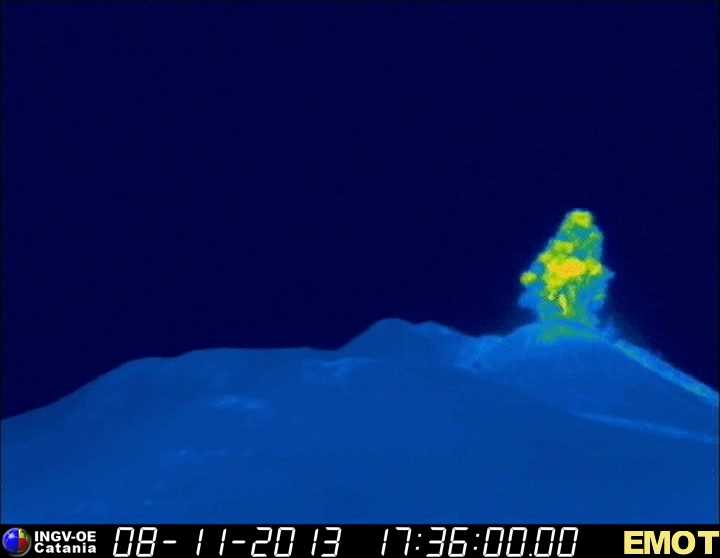
Strombolian eruption from Etna's NSEC this evening

Current tremor amplitude (ECPNZ station, INGV Catania)
No significant changes have occurred today. Tremor has decreased to low levels, but mild strombolian explosions continue to occur from time to time.
Update Fri 08 Nov 08:06

Strombolian eruption from NSEC this night
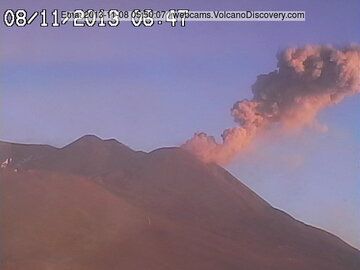
Ash emission this morning

Current tremor amplitude (ECPNZ station, INGV Catania)
Explosions from the New SE crater continued over night and this morning, although their frequency and size has decreased. Tremor levels have remained essentially unchanged and are still low.
Update Thu 07 Nov 16:01
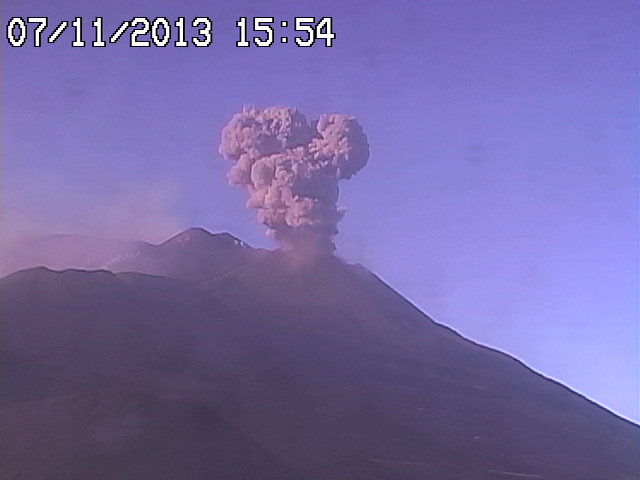
Explsion from Etna's New SE crater in the afternoon

Current tremor amplitude (ECPNZ station, INGV Catania)
Intermittent strombolian explosions continue to occur every 10-15 minutes from the New SE crater. Tremor levels are fluctuating with no clear tendency (yet).
Continuing strombolian activity at NSEC
Update Thu 07 Nov 11:30

Current tremor amplitude (ECPNZ station, INGV Catania)
Strombolian explosions have continued throughout the night and and this morning with little variations. Tremor has been rising overall, then dropped and now risen again. Judging from this, the volcano seems still "undecided" whether and when to head towards the expected 15th New SE crater paroxysm.
The following time-lapse shows the activity over the past 20 hours:
New ash explosions from New SE crater
Update Wed 06 Nov 14:02
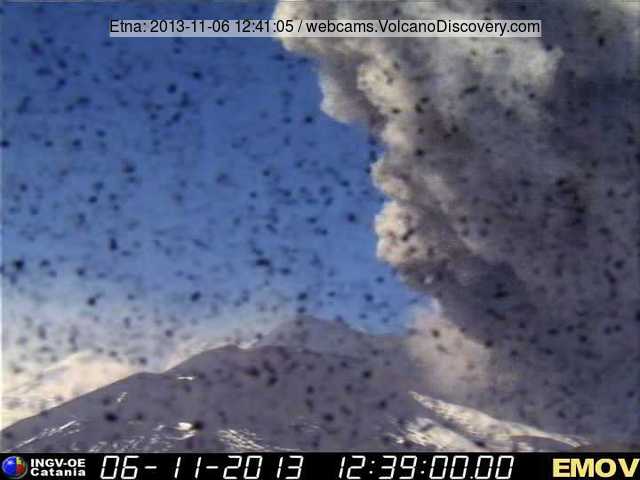
Ash emission from Etna's New SE crater

Ash emission from Etna's New SE crater
Since about an hour ago, some relatively strong explosions re-appeared to occur at the New SE crater. This could be a signal that it is heading towards a new paroxysm in the near future. Tremor continues to rise slowly. The next days (if not hours) will probably give the answer.
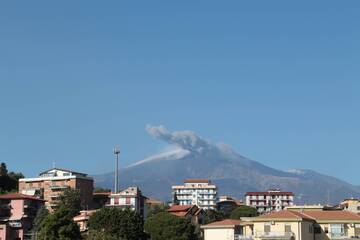
Ash plume from an eruption of the New SE crater
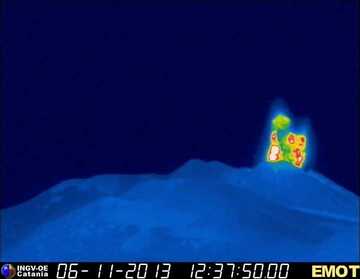
Thermal image of an explosion of the NSEC

Webcam image of an explosion at the NSEC
Explosions with ejection of incandescent material from the NSEC occurred at 11:51, 12:37, and 13:06 UTC:
Earthquake swarm
Update Wed 06 Nov 12:10
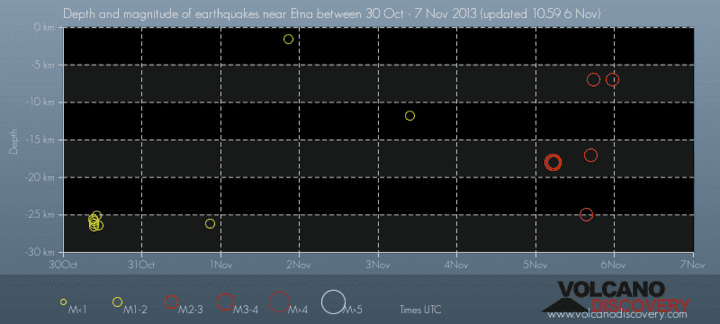
Depth vs time of earthquakes under Etna during the past 7 days

Map of recent earthquakes under Etna

Current tremor signal (ESLN station, INGV Catania)
Seismic unrest continues and gives the general impression that "something" could be in the making at the volcano.
A swarm of earthquakes at depths around 15-20 km has been going on under the SW flank, suggesting magma could be rising from deeper reservoirs into the volcano's shallower storage areas. Tremor has been showing a rising tendency, but so far, no particular eruptive activity has been observed.
Update Sun 03 Nov 11:45

Current tremor signal (ESLN station, INGV Catania)
Tremor and surface activity have continued to decrease. Once more, Etna has surprised us, this time by NOT producing a second paroxysm shortly (few days) after the one 26 Oct (as it often did after the first such eruption in the past).
Deep earthquakes under western and northern flank
Update Wed 30 Oct 18:07

Map of recent earthquakes under Etna
The volcano has been very calm (except degassing) since the last weak ash emissions from the New SE crater observed on Sunday.
However, an interesting cluster of earthquakes has been occurring during the past days. The quakes were located in two areas under the western and northern flanks at depths around 25-30 km, respectively.
Whether this is a precursor to some new activity and if so, which, is impossible to say, but one might speculate that the NE rift zone has been somehow involved and could become active again. Perhaps even the ash emissions from the NE crater during the last paroxysm are related to this.
Saturday's paroxysm produced (still hot) lava flows from the saddle vent between the old and new SE cone. The western branch cut the road leading from Belvedere to the 2900 m parking area, burnt the mountain guide's hut there and covered what little was left of the Torre del Filosofo for good. It then reached as far as into the valley between the 2002 crater and the Monte Frumento Supino. This was the first time, lava flows from the New SE cone went into this area.
First visit to our site? If you havn't done it yet,
download the Volcanoes & Earthquakes app to get one of the fastest volcano news online:
Android |
IOS

















































































